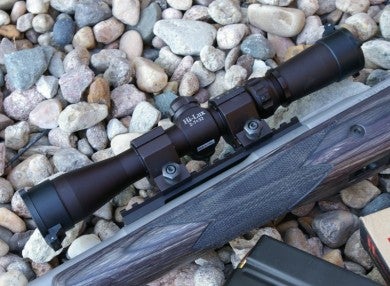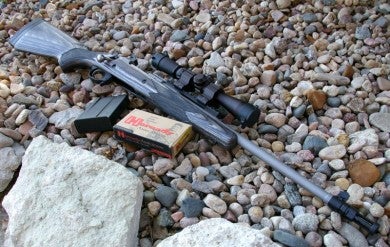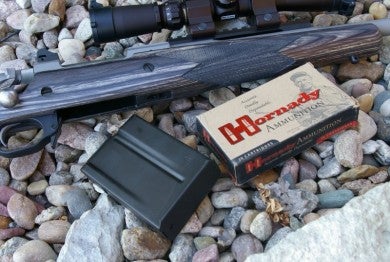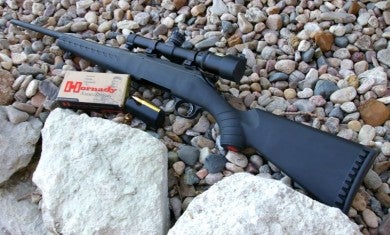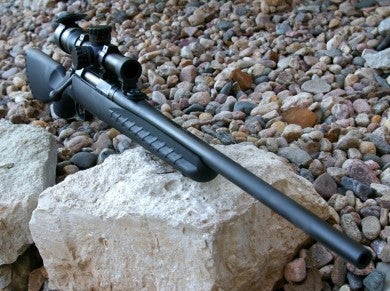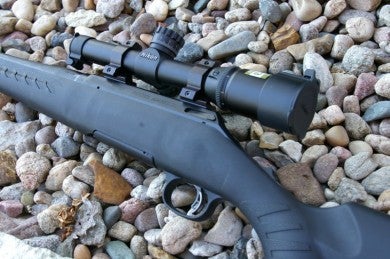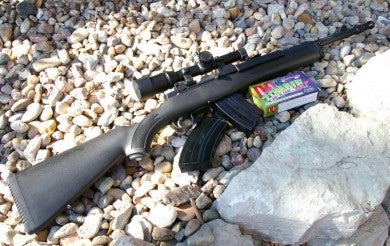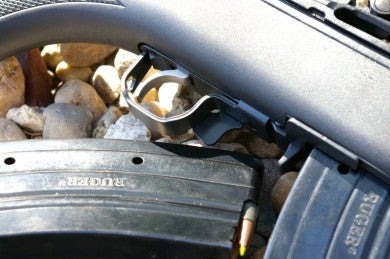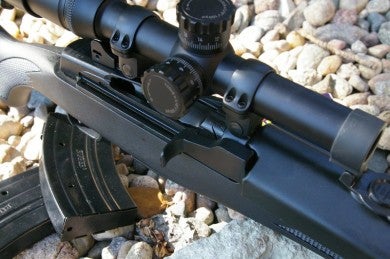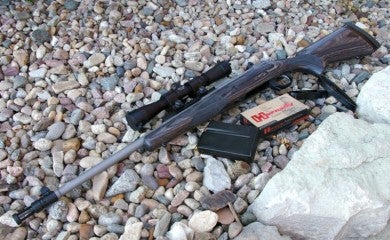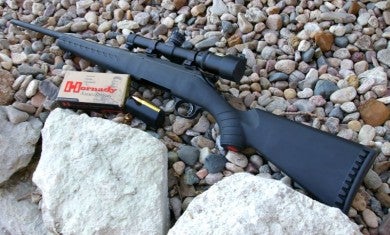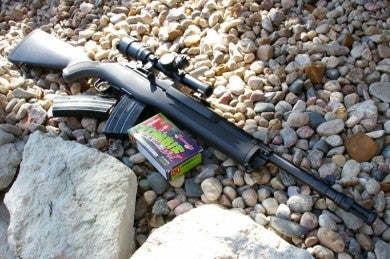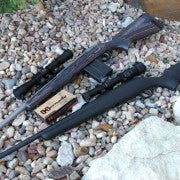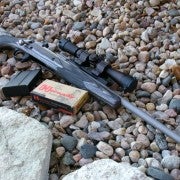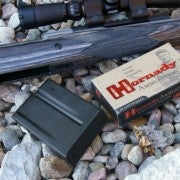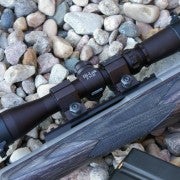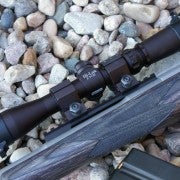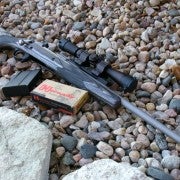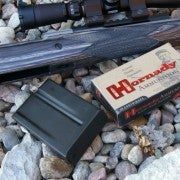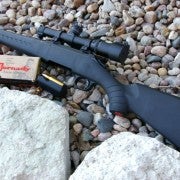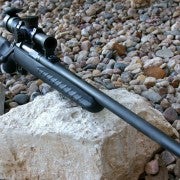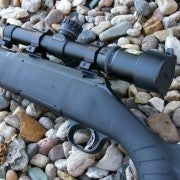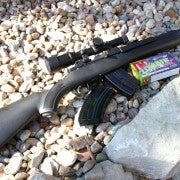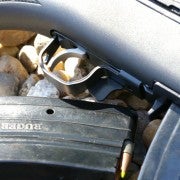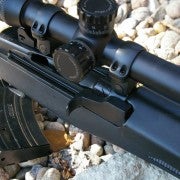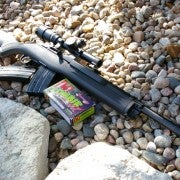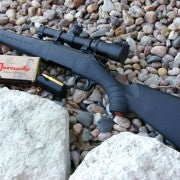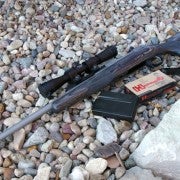Practical Testing of the Cooper Scout Rifle Concept
Major Pandemic 11.20.13
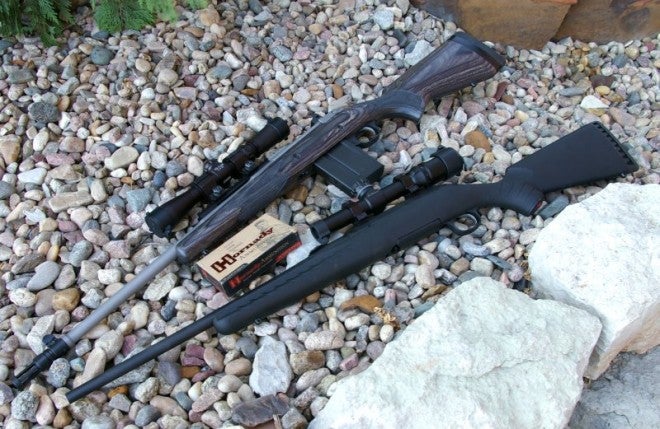
Much has been written about Jeff Cooper’s scout rifle concept. Although no one can speak more authoritatively on the subject than the late Cooper himself, I have become a student of the concept. Unfortunately, many writers have missed the spirit of the scout rifle concept, using the traits such as the light weight, .308 chambering, and overall length as mandates instead of guidelines. A point often missed was Cooper’s more important requirement of shooter capabilities. After all if you cannot hit the target, it matters little how good the equipment is.
Cooper wrote: “The natural habitat of the general-purpose rifle is the field, the forest, the desert and the mountain -– not the shooting shed with its bench rest. To be really useful a rifle must be as short, light and quick to use as is technically compatible with adequate power and useful accuracy. What matters is not what the equipment can do, but rather what it will do in the hands of its operator under field, rather than laboratory, conditions.”
Caliber Selection
Some of the more relevant scout rifle discussions have been around caliber selection. Generally, everyone centralizes on the .308 Winchester chamber, but interestingly Cooper played around with a large number of other calibers while working with Steyr. The Cooper influenced Steyr bolt action Scout rifle was offered in .223/5.56, .243, 7mm-08, .376 Steyr, and obviously .308/7.62×51 Nato. The rifle weighed in at only 6.6lbs without an optic and was only 38.6” in length. By today’s standards, it still had a number of forward thinking features, such as spare mag in the buttstock, forward mounted optic, and integrated bipod, but it was and still is priced about $2000 even if you can find one. Generally the .308 is the hardest model to find.
Cooper most widely recommended the .308 Winchester simply because it is effective on most manner of beast to 400 yards and is still readily available even in the more remote areas around the world.
Cooper first developed his scout rifle concept after looking at the very long-lived success of the Winchester 94 in the 30-30 caliber and its effective use on a wide range of hunting and defensive targets out to 200 yards for well over 100 years. The 30-30 is, by today’s standards, considered a medium weight round, and it is actually around the same 800 Ft/lbs of energy at 200 yards as a standard Russian 7.62×39 AK round (technically the AK round is more powerful). The .308 is clearly more powerful at distance, but even at 200-yards, the 30-30 and 7.62×39 are still a pretty deadly round even for whitetail and hog hunting. I decided to expand my test a bit with this in mind.
Variants of the Cooper Scout Rifle
To test my theories about the idea of a scout rifle concept and my ability to shoot them, I picked up two of Ruger‘s newest 308 bolt actions and a Mini-30 to assemble three variations: a “quintessential” Scout Rifle, an even lighter weight, more affordable, compact alternative, and the battle proven Mini-30 design with a bit more punch than the venerable 30-30.
Ruger Gunsite: The Ruger Gunsite was specifically designed around Cooper’s concept of a Scout Rifle. The design was carried out by some of his closest friends at Gunsite and matches up well to his original guidelines. Fortunately, I have the new, all-stainless version sporting a longer 18″ barrel to test out. The rifle is a brute and feels like your typical, over-engineered Ruger that could take everything you could throw at it. With this stainless version, the action is about as corrosion resistant as it comes. I topped this rifle with Hi-Lux/Leatherwood‘s newest long-eye relief variable power 2-7 Scout Rifle scope exactly where Cooper intended: way out in front of the bolt. As equipped, this rifle matches almost perfectly to Cooper’s specs, so I was looking forward to seeing whether I could deliver from a shooter perspective.
Ruger American Compact .308
The 6lb Ruger American with detachable rotary magazine has never been noted as a “Scout Rifle” since its recent introduction, but with the right optic, I figured I could prove that it might be an effective alternative to Ruger’s other namesake design.
The Ruger American that I tested is the compact version, which drops the barrel length from 22” to 18″ and shortens the length of pull by 1.25″ to deliver a very compact and ultra-light Scout Rifle variation (about 3″ shorter and 1.1lbs lighter than Ruger’s Scout Rifle). It is probably the lightest .308 in production, and considering the $350 street price on these Ruger Americans, it may be one of the least expensive options as well. To keep the weight down and deliver the both eyes open shooting capabilities noted by Cooper, I opted for something unusual on a .308 bolt action: a Nikon 1-4x P-223 AR optic. On 1X it delivers the defensive CQB distance engagement Cooper noted, and on 4X it allows some precision at distance.
Ruger Mini-30: Aside from the 7.62×39 chambering and forward mounted optic, the Mini-30 is the semi-auto version of the Gunsite scout rifle. Brutally tough and infallibly dependable, perhaps Ruger should offer this in a .308 version. The $799 street priced Mini-30 that I tested was a simple blued 16” barreled version that includes about the same accessories as the Scout. It comes complete with a birdcage flash hider, virtually the same iron sights, two 20-round magazines, 1-inch scope mounts, and even a weaver scope mount rail. This rifle shared the same Nikon 1-4x P-223 optic with the American.
Accuracy and Testing
Some writers inaccurately note that precision accuracy is not a requirement for a scout rifle. This was not true, as Cooper’s definition was a rifle and shooter capable of field accurate 4″ groups at 200 yards. This is not particularly accurate for today’s modern factory rifles from the bench, but delivering that accuracy in the field under less than optimal situations is a bit harder. From the specs, any of these rifles should be capable of this accuracy, but let’s see if I am.
I set up four tests, varying the shooting positions and respective distances: standing at 50 yards, kneeling at 75 yards, sitting at 100 yards, and supported prone at 200 yards and 400 yards. Standing, kneeling, and sitting positions were stabilized via national match style sling, and the 200- and 400-yard supported prone position was shot with the rifle supported over my pack.
The idea was simple: hit a large 4-inch can of corn at each distance out to the 200-yard line and then be able to ring the 400-yard 12-inch gong and do it at a pretty brisk pace. Hit a can of corn with a .308 or 7.62×39 Hornady Z-Max round, and you know it. “Corn. It’s what’s for dinner in a 20-yard radius.”
In most cases, this pace meant that if I hit each shot of the entire five shot string, the entire test would be over in around 30-40 seconds with a rather joyous spray of corn everywhere. This was also a no excuses test repeated three times. If I screwed up, flinched, or didn’t concentrate on the fundamentals of the shot, then it reflected in my performance.
My Performance
Ruger Gunsite: The Ruger Gunsite delivered a near perfect performance. Running the four corn can gauntlet three times with the Scout delivered only one miss out on the 200-yard line can, but this was more my fault than the Scout’s. My first run was at 32 seconds, the second at 29, and on the third I got cocky and missed the 200-yard can. That miss cost me me with a 44 second time.
Ruger American Compact .308: With the American, things were not so easy the first round. Part of this was that the 1lb lighter gun and shorter length (read that as 1-inch too short for me) may be lighter to carry, but it is harder to stabilize offhand and packs a brutal recoil on multiple shots. After the first very brutal round, I added a slip-on Limbsaver over the existing buttpad, and the American was suddenly transformed into something I wanted to shoot. The result was that the first attempt at the 50 and 200 yard lines required second shots, but once the extra pad was on, I nailed every shot on the next two runs except one other miss on the 200-yard line. My first time was just under 60 seconds, one under 45, and the perfect last run timed in at 35 seconds.
Ruger Mini-30: The Mini-30’s performance shocked and stunned me. The Mini-30 was actually the clear stopwatch winner even though I had to send a couple extra rounds down range on the 200 on two runs and one extra on the 100-yard can on what would have otherwise been a perfect run. With all the extra bullets down range, two of the runs were under 30-seconds, and one was under 40. It required the highest round count but delivered the best times.
Oddly enough the 400-yard 12” gong was by far the easiest target off all to hit, with the 200-yard corn can giving me the most issues with all guns.
Final Thoughts
This exercise will certainly get your heart rate up and show you all your horrible flaws in less than three one-minute sessions. Cheap training is grabbing your trusty .22 LR and connecting with 25 to 100-yard spinner targets.
I also proved that a $350 street priced Ruger American rifle can make a pretty decent Scout rifle with just a fat buttpad and the right, low powered optic attached. The American Compact performed almost as well as its $799 street priced big brother.
Finally, I proved to myself that although you may be limiting yourself from a range and power perspective, the Mini-30 is one surprising little, accurate scout rifle at under 300 yards, with a decently powerful, cheap-to-feed cartridge.
Get off the bench, I double dog dare you. Your abilities change considerably once you add a timer and force yourself to transition between each of these shooting positions. Now go buy some cheap canned corn and create your own perfect scout rifle.
